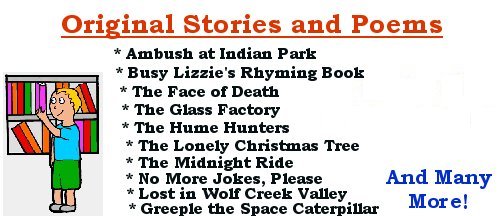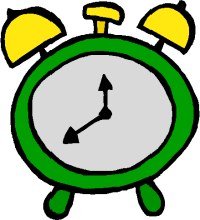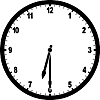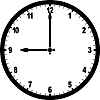
 |
Return to Say-it-in-English Entry Page
Return to English for Everyday Living home page.
Telling Time Morning, Noon and Night
If you want to tell a friend what time he should meet you, you need to know how to say the time in English. If your boss tells you to be at work at a certain time, you will need to understand what those words look like on the face of a clock. You will need to know how to write the time as well as say it. You will need to be able to tell the time even if the clock face has no numbers on it, or if it uses Roman numerals instead of the ones we are used to (Arabic numerals). Finally, you will need to figure out the time whether you are looking at an Analog clock (from 12 to 24 numbers with 2 or more pointers that move from number to number) or a digital clock, one that shows just one set of numbers that change as time passes. Most civilian clocks divide the day into 2 twelve-hour segments. From one second after midnight (12:00:01) until twelve o'clock noon is considered to be morning and is shown by adding A.M. (ante meridiem) to a time. Examples: 3:32 A.M. (three thirty-two AM) or three thirty-two in the morning. From one second after Noon until twelve-o'clock midnight is indicated by P.M. (post meridiem) after the time. This segment is split up into the Afternoon (12:01 P.M. until 5:00 P.M.), Evening (5:01 P.M. until 8:00 P.M.), and Night (8:01 P.M. until Midnight). The exact times of these segments can vary from person to person and from culture to culture.
 |
 |
|
| This clock reads 7:05 in Roman numerals. | This clock uses dashes, not numbers, so one tells time by the position of the arrows, not by numbers. | |
 |
||
| This special clock in London, England, shows a 24-hour day in Roman numerals. | This example of a digital clock face shows 12 o'clock, but noon or midnight? | |
 |
||
| This digital clock shows 8:23, but is it morning or evening? | This is a common style old-fashioned analog alarm clock. |
[Some places and organizations use the 24-hour or military way to tell time. A day is divided into 24 segments, each being one hour long, beginning one second after midnight and ending at the next midnight. Examples of some of the times: 0005 = five minutes after midnight or 12:05 AM; 0145 = one hour and forty-five minutes in the morning or 1:45 AM; 0600 = six hours after midnight or 6:00 AM; 1159 = eleven hours and fifty-nine minutes after midnight or one minute 'til noon - 11:59 AM; 1200 = Twelve hundred hours or twelve o'clock noon - 12:00 (Civilian time begins counting from one again until the time reaches midnight. Twenty-four hour time continues counting from twelve to thirteen to seventeen, up to twenty-four hundred hours, or midnight); 1330 = thirteen hours and thirty minutes after midnight or one hour and thirty minutes after noon (1200) - 1:30 PM; 1700 = seventeen hundred hours or five hours after noon - 5:00 PM; 2120 = nine hours and twenty minutes past noon or 9:20 PM.]
| Telling time and using a clock are parts of almost everyone's daily activities. Many people start their days with the sound of an alarm clock. |
page break
|
Sometimes, the alarm
has the sound of a clanging bell |
page break
sometimes it is an
irritating buzz  |
page break
and other times it has the sound of music or an announcer's voice

|
page break
Several times as you get dressed, get your kids dressed, and eat
breakfast, you will glance at the bedroom clock, the wall clock in the kitchen
 |
.
page break
or
your wrist watch  to be sure you have enough time.
to be sure you have enough time. |
As you drive to work, you will check your wrist watch again, or maybe look at the clock in front of the bank, to make sure you will get to work on time. Throughout the day, you will look at your watch or the wall clock to see if it is time for your coffee break or lunch. Sometimes, meetings or appointments are scheduled at specific times, so you have to look at your watch often so you don't miss them. Sometimes, meetings last much longer than you want, so you will look at your watch many times, wishing you could make the time go faster. Finally, you see by the wall clock that it is time to get ready to go home. Then, as you sit in the long lines of traffic, you look at your watch often, wondering when you will finally reach home. During the evening, you will refer to some kind of clock many times in order to cook supper, get the kids to ball practice or piano lessons, make sure the kids get home when they are supposed to, to watch a special TV show, and finally to get everybody to bed at a decent time. So you can see that telling time is an essential part of your everyday life.
 |
 |
 |
||
| 12:00, twelve o'clock noon or twelve o'clock midnight. | 12:05 or twelve-oh-five or five minutes after twelve. | 12:15, twelve fifteen, fifteen after twelve, a quarter past twelve, a quarter after twelve. |
page break
 |
 |
 |
||
| 12:30, twelve thirty, thirty past twelve, half past twelve. | 12:45, twelve forty-five, fifteen minutes 'til one, forty-five minutes after twelve, quarter to one.* | 1:00. One o'clock in the afternoon (PM) or one o'clock in the morning (AM). | ||
 |
 |
 |
||
| 1:08 AM (morning) or 1:08 PM (afternoon). eight minutes past one, one-oh-eight. | 1:15, one fifteen, fifteen minutes after one, quarter past one | 1:30, one thirty, thirty minutes past one, half past-one |
page break
 |
 |
 |
||
| 1:45, one forty-five, forty-five minutes after one, fifteen minutes til two, quarter to two.* | 2:00. Two o'clock in the morning (AM) or two o'clock in the afternoon (PM). | 2:15. Two fifteen. Fifteen minutes after two. Quarter past two. Quarter after two. | ||
 |
 |
 |
||
| 2:30. Two thirty. Thirty minutes past two. Half past two. | 2:45. Two forty-five. Forty-five minutes after two. Fifteen minutes 'til three. Quarter to three.* | 2:04. 2-oh-four. Four minutes past two. | ||
 |
 |
 |
||
| 3:00 AM or PM. Three o'clock. | 3:15. Three fifteen. Fifteen minutes past three. Quarter after three. | 3:30. Three thirty. Thirty minutes past three. Half past three. |
page break
(* - When we talk about a time before the next hour, the correct form would be "twenty minutes until five" or "fifteen minutes until seven" or "a quarter (of an hour) until eight". However, in many situations "until" is shortened to 'til ("thirteen minutes 'til three") and in the average conversation, "until" is shortened even more, finally sounding like "tuh", or maybe like a T with just a hint of a vowel sound after it. It could be written as t' in the following expressions: "quarter t' one" or "twenty t' five." Just remember that what you hear or say can be very different from what you must write.)
 |
 |
 |
||
| 3:45. Three forty-five. Forty-five minutes after three. Fifteen minutes 'til four. Quarter to four.* | 4:00 AM or PM. Four o'clock. | 4:10. Four ten. Ten minutes after four. | ||
 |
 |
 |
||
| 5:00 AM or PM. Five o'clock. | 5:20. Five twenty. Twenty minutes after five. | 6:00 AM or PM. Six o'clock. | ||
 |
 |
 |
||
| 6:15. Six fifteen. Fifteen after six. Quarter past six. | 6:30. Six thirty. Thirty minutes after six. Half past six. | 6:45. Six forty-five. Forty-five minutes after six. Fifteen minutes 'til seven. Quarter to seven.* |
page break
 |
 |
 |
||
| 7:00 AM or PM. Seven o'clock. | 7:05 in Roman numerals. Seven-oh-five. Five past seven. | 8:00 AM or PM. Eight o'clock. | ||
 |
 |
 |
||
| 8:15 AM or PM. Eight fifteen. Fifteen minutes after eight. Quarter past eight. | 8:30. Eight thirty. Thirty minutes after eight. Half past eight. | 8:45. Eight forty-five. Forty-five minutes past eight. Fifteen minutes 'til nine. Quarter to nine. | ||
 |
 |
 |
||
| 8:55. Eight fifty-five. Fifty-five minutes after eight. Five minutes 'til nine. Five to nine.* | 9:00 AM or PM. Nine o'clock. | 9:15. Nine fifteen. Fifteen minutes past nine. Quarter after nine. |
page break
Roman Numerals: I = 1, II = 2, III = 3, IV = 4, V = 5, VI = 6, VII = 7, VIII = 8, IX = 9, X = 10, XI = 11, XII = 12
 |
 |
 |
||
| 9:30. Nine thirty. Thirty minutes after nine. Half past nine. | 9:40. Nine forty. Forty minutes after nine. Twenty minutes 'til ten. Twenty to ten.* | 9:45. Nine forty-five. Forty-five minutes after nine. Fifteen minutes 'til ten. Quarter 'til ten. | ||
 |
 |
 |
||
| 10:00 AM or PM. Ten o'clock. | 10:30. Ten thirty. Thirty minutes after ten. Half past ten. | 10:45. Ten forty-five. Forty-five minutes after ten. Fifteen minutes 'til eleven. Quarter to eleven.* | ||
 |
 |
 |
||
| 11:00 AM or PM. Eleven o'clock. | 11:05. Eleven oh five. Five minutes after eleven. | 11:30. Eleven thirty. Thirty minutes after eleven. Half past eleven. |
page break page break
Here are some questions and statements you might use involving time.
|
1. What time is it?
3. When do you have to be at school? 5. Do I have enough time to finish eating? 7. What does your watch say? 9. When will you pick me up? 11. Will the movie start on time? 13. How long will the movie last? 15. When will the test begin? 17. How much time do we have before dinner? 19. Do you get time for lunch? 21. How many minutes until bed time? 23. When will we get to the park? 25. Can you kids keep quiet for a whole five minutes? 27. No, you can't. 29. See, I told you so.
|
2. Tell me what time it is.
4. You have to set your alarm for six o'clock. 6. Lunch will be ready at twelve-thirty. 8. The kitchen clock says it's five minutes 'til eight. 10. Pick me up right after work. 12. The movie will start at ten minutes after three. 14. The movie will last two hours and twenty-five minutes. 16. The test will begin in twelve minutes exactly! 18. I work from seven in the morning until three-thirty in the afternoon. 20. We get half an hour for lunch, from eleven-thirty 'til noon. 22. You have to go to bed in fifteen minutes. 24. We won't get to the park for another hour. 26. I'll bet I can go without talking for six minutes. 28. Yes, I can. 30. That's no fair! You cheated. |
Exercise: Study the questions and statements above. Read them to yourself, then find someone who will listen to you as you read them. Write each of the questions, then write an answer for each one. You can use the answers above or make up your own answers. Get a partner to work with you; ask each other the questions and then listen while the other person answers.
� c. 2000 - 2017 Montoursville, PA 17754
 Hundreds of My Favorite Songs from the 50's, 60's, 70's and 80's.
Hundreds of My Favorite Songs from the 50's, 60's, 70's and 80's.
Links to videos, lyrics of the songs and Wikipedia biographies of the artists, plus Then and Now photos.